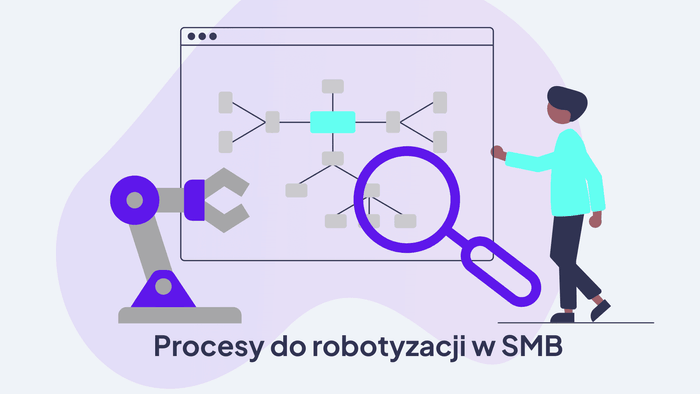Business Process AutomationLearn more
How do we identify the right process for Robotic Process Automation in a small or medium-sized company?

Robotic Process Automation (RPA) has become firmly established in banking, insurance and other large businesses. In these types of organizations, it is not difficult to decide which processes should be automated first, due to their scale. The case is slightly different for companies in the SMB segment. Here, it is definitely more difficult to identify such processes and appoint the person responsible for finding them and calculate RPA profitability.
Before we start process identification for RPA
There are many ways, technological and otherwise, to optimise processes. The search for the first process for Robotic Process Automation should be based on your answers to some general questions.
What do I want to achieve with robotic process automation?
There is a belief that automation is designed to replace humans, or in other words to cut a specific number of jobs. Indeed, this is a more common approach in large RPA projects. In SMB companies, these savings are not directly reflected in the process cost itself, so when considering Robotic Process Automation it is also a good idea to look at the other benefits we can achieve:
- Efficiency improvement – our goal may be to provide employees with the tools to be more productive.
- Error reduction – if the cost of an error in a process is high in your industry, RPA may be a good idea
- Making the process independent of people – if you recognise the danger of key processes in an organisation being dependent on the availability of people, then such independence could be the goal of RPA.
- Better team satisfaction - you may find that implementing RPA does not reduce costs, but it will increase team satisfaction.

Who is to be responsible for identifying processes for automation?
In large organisations, separate teams are set up to identify processes and develop automation knowledge across departments. So how do you approach this in a smaller organisation? Should it be IT, business people or perhaps a designated person from each department? Here, unfortunately, there is no single answer. It very much depends on what the organisation looks like. One thing is certain: it is the business and those in management who should look after the project, as they are the ones able to delegate work effectively and have the broadest view of how it looks from a company-wide perspective.
Is automation of business processes the best way to automate in my case?
Automation applied to an efficient operation will increase productivity. Automation applied to an inefficient operation will increase the inefficiency.” Bill Gates
RPA is just a tool, one of many, for automation and optimisation within the company. However, to be effective, it needs to have the right input data. In the case of RPA, it is about properly defined processes. In addition, these processes should be mature. In addition, we need to be aware that in many cases we will find other tools to deliver the expected results more quickly and easily. A case in point is the combination of RPA and workflow platforms. More on this topic in: Robotic Process Automation (RPA) and Business Process Management (BPMS) - why you need to combine them.
How do we identify processes for Robotic Process Automation?
Firstly, we need to be aware SMB companies are unlikely to implement robots in a way as to automate 100% of the processes currently carried out by human workers.
Harward Business Review suggests we should first break down the process into constituent tasks to look for activities that can be automated. For this, we need to understand that work can be considered in a number of ways:
- Repetitive/variable
- Individual/team work
- Manual/intellectual

From the RAP point of view, we should look for tasks that are repetitive, executed by a single person and do not require physical action. Once we have successfully broken down processes into tasks, it is time to decide whether they are suitable for automation. The best way you can do it is by addressing the following questions or tasks:
- Is the task rule-based?
- Is the task large-volume and large-scale?
- Are there many exceptions?
- Is the task properly defined and mature?
- Does it change over time?
- Is the task based on structured data in digital form?

The ‘rule of five’ as a way to select a process for RPA
To confirm that the candidate we have identified is a good process for RPA we can use The Rule of Five proposed by Forrester. It says that the process transferred should not:
- Require more than 5 decisions
- Use more than 5 applications
- Include more than 500 clicks
Summary - identifying processes for RPA in SMB companies.
If you are just wondering whether Robotic Process Automation is a good idea for your organisation, make an appointment for a free meeting with our consultant. In this free-of-charge 30-minute chat, we will tell you whether and how to approach process automation in your company.
You can make an appointment for a consultation here: Consultation for process automation in SMBs
